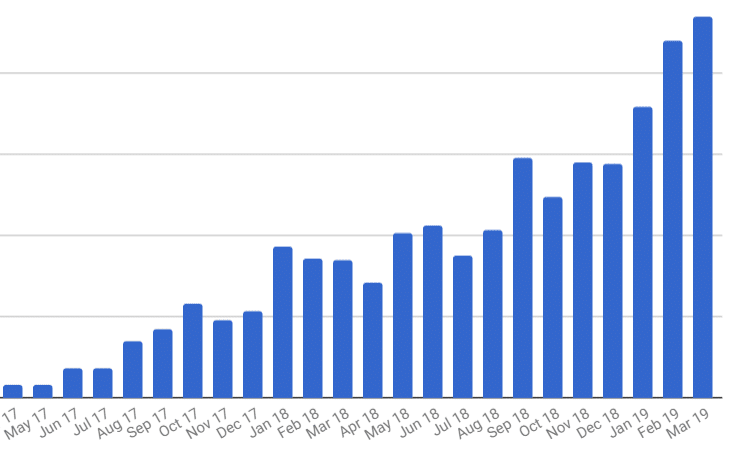Want to see what RevenueZen’s monthly recurring revenue growth looks like? We’re at the 2 year mark, and it’s time to share under the hood. Where are we at? How did we get here? Where are we headed? More importantly, what have we learned that can help you?
Monthly Recurring Revenue (MRR)

That’s our monthly recurring revenue growth. Yes, MRR. Even though we’re not a SaaS company, that’s the world we live in. SaaS growth is what we live and breathe.
Even though we’ve had some dips, the trend is consistently up. So far, we’ve averaged 20% MoM growth in recurring revenue. In the process, we’ve grown from our founding team handling everything (which is still true sometimes) to a kickbutt team of 18 people across sales, marketing, and customer success.
Where Are We Finding Clients?

Looking at the breakdown of lead sources from last year, around 58% have been from referrals, 9% from outbound, and 33% from inbound. Like most agencies and early-stage companies, the bulk of our business has come through referrals from our network and happy customers.
Many of the companies I talk to are starting from a position of 80-90% of new business coming through referrals and warm introductions. They want to diversify their customer acquisition channels but often they’re still relying almost entirely on referrals and word-of-mouth.
I’m not saying that referrals are bad. Referrals are amazing, as they’re a testament to the great work that your team is doing to get results for your customers! If that’s where your company is at, keep it up! The challenge is that referrals aren’t scalable and they aren’t predictable. You can build a foundation with them but you can’t continue to grow indefinitely like that.
Outbound Sales
On the outbound side, despite generating thousands of sales meetings for clients through outbound channels, we only sourced around 9% of our new closed won MRR last year from it. In our client outbound sales campaigns, we’re running everything from enterprise, account-based sales development campaigns to large-scale cold email campaigns that rely more on smart segmentation over individual personalization.
For ourselves, we tend to be highly targeted and personalized in our cold messages. When we see someone who is a (potential) good fit, we reach out to them directly through LinkedIn and email with a highly personalized message.
Inbound Marketing
The 33% of new recurring revenue that we’ve won from inbound marketing has been a steadily growing source of revenue for us.
What do I mean by inbound here? I’m talking specifically about organic traffic from SEO and customers who come to us through LinkedIn and Quora.
Our CEO, Alex Boyd, has done a fantastic job from the start of generating inbound leads using LinkedIn. You can see how he does it by clicking the button below.
| Get The LinkedIn Course |
Some of these people contact us by directly sending me or Alex a message via LinkedIn. Others see us on LinkedIn, visit our website, and sign up for a free consultation. On average, we’re seeing 15 inbound leads per month, with 40% coming directly through LinkedIn and 60% through our website. Like everything else, this number is trending upwards.
It’s too soon to celebrate, though. Inbound is a marathon.
While our outbound sales campaigns produces results quickly, generating meetings within days/weeks of launch, inbound and content marketing takes more time to build momentum. However, once it starts working, results come in steadily, predictably, and, most importantly, get stronger over time. Outbound requires constant activity to continue to see similar results month over month. Content will only strengthen with time, assuming you’re starting with valuable content that’s well-optimized.
Revenue Goals for 2019
In Q1 2019, we had a strong start to the year. Our focus continues to be finding excellent-fit clients who we’re confident we can do good work for. It hasn’t always been easy by any means. There have been slumps where sales meetings and pipeline creation slows down. We’ve lost deals we thought we’d win. Won deals that we should have passed on. Passed on deals we should have taken.
Our target for 2019 is to double our MRR from December 2018 by December 2019. We’re well on our way to that target, but it’s going to take quite a bit more work on all fronts.
Not only that, but as we build RevenueZen the brand, we need to make sure that our growth strategies are scalable, repeatable, and predictable. This means we’ll be making a much more focused effort on our own content and inbound marketing while systematizing our sales and client acquisition and onboarding processes.
Revenue Growth Lessons
The main lesson I’ve learned from these last couple years is patience. Our company is built on the fact that we understand growth.
We know how to connect with decision-makers. We understand how to create valuable content that people can find. We know how to deliver on our promises to clients. There’s no magic bullet for revenue growth aside from doing the work, and no amount of understanding growth can replace actually doing the work of growth.
I talk to founders all the time who tell me they “tried outbound” or “tried inbound” and it didn’t work. When I dig deeper to find out what happened, I usually discover that they tried a few tactics over the course of a couple months, didn’t see any results, and either gave up or, more likely, got busy with other parts of the company and stopped trying.
Just like there’s no magic bullet for revenue growth, there are far more wrong ways of running a sales or marketing campaign than there are right ways. Your product, your market, your resources, and your team are going to dictate which revenue growth strategies are the most appropriate for you at any given time.
Is what you’re doing right now not working? Maybe your targeting is off. Maybe your messaging is wrong. Maybe your content is bad. Maybe you just need more patience.
Maybe it’s all of the above.
Usually, I find that people simply aren’t sitting down consistently and doing the work. When our pipeline is low, and I take a good, hard look in the mirror, I usually find that it’s because I’m not doing the right work. Growth is a process. There are specific activities that will lead to predictable outcomes. If you’re not getting the outcomes you want, you’re not doing the right activities.
So, what growth work do you know you should be doing that you’re not? Now ask yourself “why not?”




